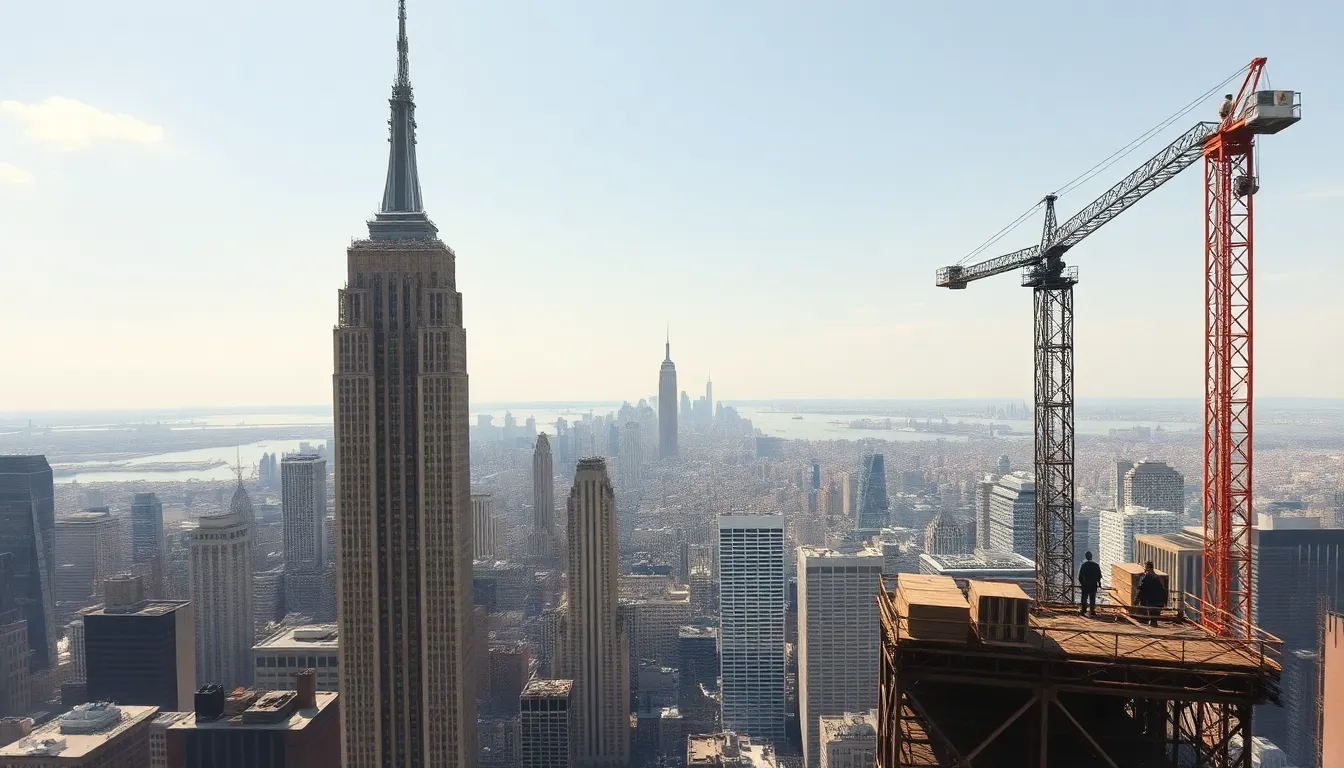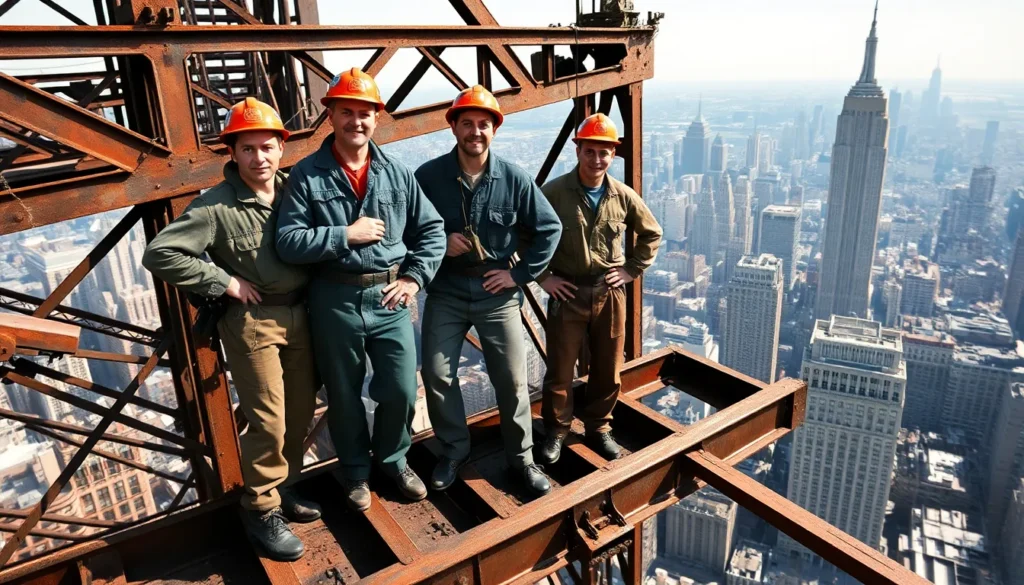Table of Contents
ToggleWhen it comes to architectural marvels, few can rival the Empire State Building. This iconic structure has been a symbol of ambition and innovation since its construction in the early 20th century. But what if the walls could talk? Imagine the stories hidden behind those steel beams and bricks, captured in a treasure trove of construction photos that chronicle its rise to greatness.
Overview of the Empire State Building
The Empire State Building stands as an iconic skyscraper in New York City, capturing the essence of early 20th-century aspirations. Completed in 1931, this 102-story marvel reaches a height of 1,454 feet, including its antenna, making it one of the tallest structures in the world. Architects Shreve, Lamb, and Harmon designed the building in the Art Deco style, a reflection of elegance and bold design.
Exceeding its architectural significance, the Empire State Building symbolizes American resilience during the Great Depression. Construction began on March 17, 1930, and took just over a year to complete, a remarkable feat given the economic challenges of the era. Workers erected the building at an unprecedented pace, often reaching several floors added each week.
Photos from the construction reveal a glimpse into the era, showcasing laborers working atop steel beams high above the city. These images capture not just the physical construction, but the spirit of collaboration and determination among those who created the structural masterpiece. Over 3,400 workers contributed to its construction, highlighting the collective effort that embodied New York’s ambition.
The building features a distinctive limestone and granite facade, enhancing its visual impact among the city’s skyline. An observatory on the 86th floor offers breathtaking views, drawing millions of visitors annually. Its significance extends beyond its architecture, serving as a backdrop to numerous films and media, reinforcing its status as a cultural touchstone.
As a National Historic Landmark, the Empire State Building continues to awe with its stunning views and intricate details, making it a vital part of New York’s identity.
Historical Significance

The Empire State Building holds deep historical significance as a symbol of resilience and innovation. Its construction during the Great Depression exemplifies the unwavering spirit of New Yorkers and the nation.
Impact on New York City
The Empire State Building reshaped New York City’s skyline upon its completion. This iconic structure became a hub for commerce, attracting businesses and tourists alike. It symbolizes the city’s economic rebirth during a difficult era. Thousands of workers contributed to its swift construction, showcasing the collaborative energy prevalent in the city. The structure’s height and design influenced later skyscrapers, establishing a new standard for urban architecture. Cultural references in films and literature further solidified its status as a quintessential New York City landmark.
Architectural Innovations
Architectural innovations defined the Empire State Building’s design and construction. A pioneering use of steel frame construction allowed for the rapid development of its height. Art Deco elements in its facade exemplify the elegance of the era, blending functionality with aesthetic appeal. The incorporation of an observatory on the 86th floor revolutionized urban experiences, offering breathtaking views of the city. The skyscraper also implemented advanced technologies for its time, including high-speed elevators and a sophisticated air conditioning system. Such innovations influenced future architectural endeavors, establishing newer paradigms in building design.
The Construction Process
The Empire State Building’s construction process epitomizes efficiency and innovation. Completed in just over a year, construction began on March 17, 1930, and wrapped up in April 1931. The project timeline features milestones like the topping out at 1,454 feet on September 21, 1930. Each stage, from excavation to the final touches, relied on a dedicated workforce exceeding 3,400 skilled laborers. Their efforts resulted in an impressive multi-floor addition weekly, reflecting a remarkable industry pace.
Timeline of Construction
March 1930 marked the project’s initiation. On May 1, groundbreaking ushered in heavy machinery and excavation. By June, the foundation was set with concrete and steel support. The steel framework surged skyward throughout summer 1930, reaching milestones regularly. Significant progress occurred in September when the building hit its highest point. Bying the New Year, exterior façade work commenced. Final inspections followed in April 1931, catalyzing the grand opening.
Techniques Used in the Building Process
Innovative techniques characterized the building process. Steel frame construction maximized height and stability, allowing the structure to rise swiftly. Assembly line methods streamlined labor tasks, ensuring efficient workforce coordination. Prefabrication played a crucial role, reducing onsite assembly time and minimizing weather delays. Advanced high-speed elevators enhanced visitor access, accommodating rapid movement throughout the skyscraper. Moreover, extensive use of Art Deco elements infused aesthetic appeal, influencing urban architecture for decades.
Notable Construction Photos
Photos from the Empire State Building’s construction reveal the extraordinary efforts and challenges faced by workers. Each image tells a unique story of determination and achievement during an ambitious project.
Iconic Images and Their Stories
Iconic images capture critical moments, showcasing workers high above the streets of New York City. One compelling photo depicts laborers joyfully posing on a steel beam, highlighting the camaraderie among the team. Another image shows the topping out ceremony, representing a significant milestone in architectural history. Each photograph not only illustrates the progress made but also reflects the spirit of perseverance during the Great Depression. Through these visuals, viewers gain insight into the daily lives and aspirations of those involved in building the landmark.
Photographers and Their Contributions
Several photographers documented the Empire State Building’s construction, each adding their artistic perspective. Lewis Hine captured striking images of workers, emphasizing their bravery and skill. His work played a crucial role in raising awareness about labor conditions and the human element in construction. In contrast, Berenice Abbott focused on the building’s structural elegance, creating evocative images that highlight its Art Deco design. Collective contributions from these photographers helped preserve rich visual narratives that continue to inspire admiration for the building. Their insights into both the labor force and architectural majesty have solidified the legacy of the Empire State Building in photographic history.
Preservation of Construction Photos
Preserving construction photos of the Empire State Building holds significant importance. These images provide a breathtaking window into the ambitious project that reshaped New York City’s skyline. Iconic photos capture moments of resilience from workers, showcasing both their challenges and successes during the Great Depression.
Lewis Hine’s photographs, for example, reveal the bravery and craftsmanship of laborers. Each image not only documents the construction process but also pays tribute to their contributions. Berenice Abbott’s work highlights the building’s elegant design, focusing on its architectural beauty from unique angles. Together, these photographers offer varied perspectives that enrich historical narratives.
Maintaining these photos involves careful archiving practices. Important steps include digitizing, cataloging, and restoring original prints. Digital archives enhance accessibility, allowing more people to appreciate this critical part of history. For historians and enthusiasts alike, engaging with these visuals fosters a deeper understanding of the Empire State Building’s legacy.
Institutions like the New-York Historical Society ensure that these invaluable images are preserved. Public exhibitions showcase this rich collection, inviting local communities and international visitors to experience the building’s history. Multifaceted programs linking photography with architecture encourage new generations to draw inspiration from the past.
Documenting construction photos continues to be crucial for future generations. Professionals and amateurs alike acknowledge the need for stewardship, ensuring that this visual history remains intact. Educating the public on the significance of these images strengthens the connection people feel towards this symbol of perseverance and ingenuity.
The Empire State Building stands as a testament to human ingenuity and resilience. Its construction photos not only document an architectural marvel but also capture the spirit of a generation determined to overcome adversity. These images are vital in preserving the rich history of the building and the stories of those who contributed to its creation.
As the Empire State Building continues to inspire millions, the photographs serve as a powerful reminder of the collaborative effort that brought this iconic structure to life. By cherishing and sharing these visual narratives, future generations can appreciate the legacy of innovation and perseverance that the Empire State Building represents.







